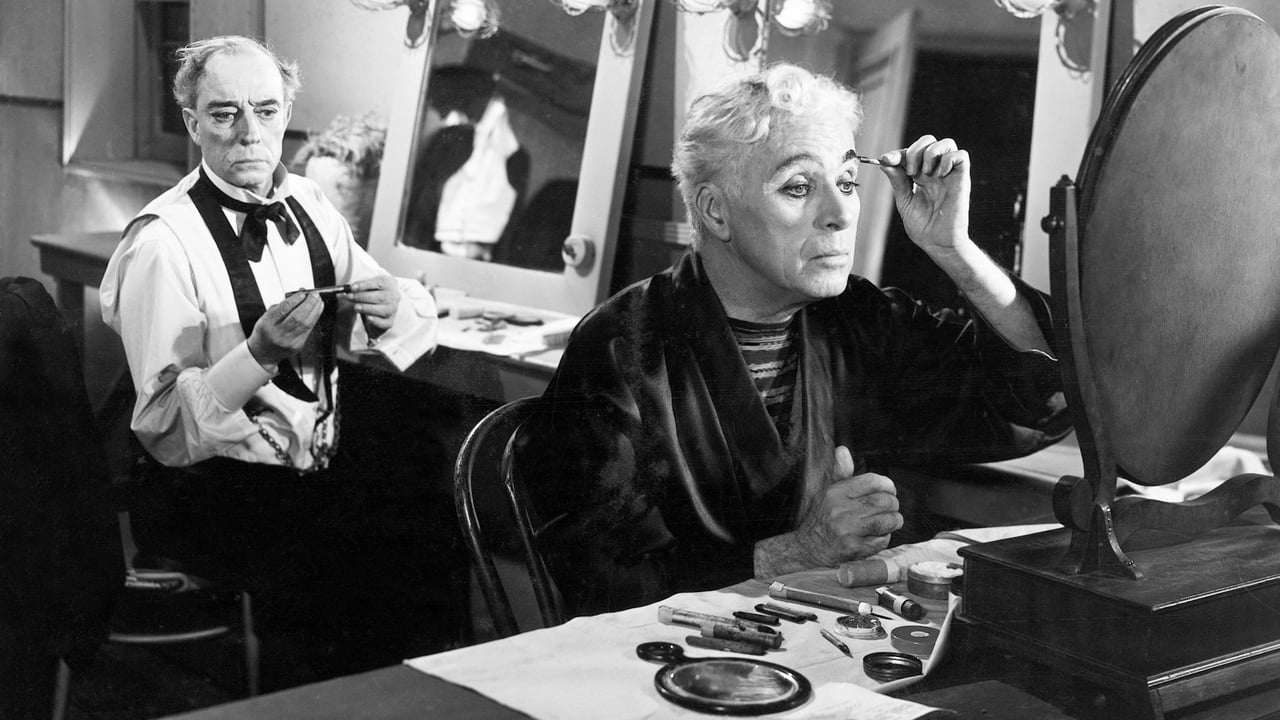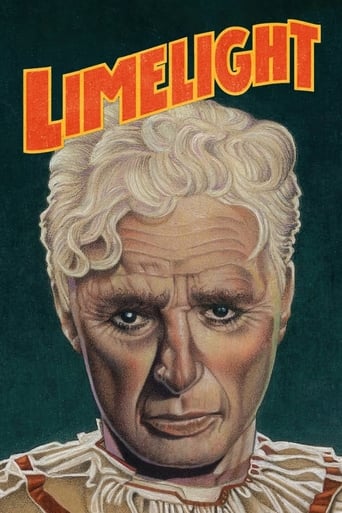Rijndri
Load of rubbish!!
Stellead
Don't listen to the Hype. It's awful
Reptileenbu
Did you people see the same film I saw?
Doomtomylo
a film so unique, intoxicating and bizarre that it not only demands another viewing, but is also forgivable as a satirical comedy where the jokes eventually take the back seat.
JohnHowardReid
Associate director: Robert Aldrich. Art director: Eugene Lourié. Choreography: Charles Chaplin, André Eglevsky, Melissa Hayden. Music: Charles Chaplin. Music director: Keith Williams. Music orchestrations: Ray Rasch. Songs: Charles Chaplin, Ray Rasch. Celebrated — United Artists. Producer: Charles Chaplin.Copyright 23 October 1952 (in notice: 1951) by Celebrated Films Corp. Released through United Artists. New York opening simultaneously at the Astor and Trans-Lux Sixtieth Street: 23 October 1952. U.S. release: 6 February 1953. London opening at the Odeon, Leicester Square: 23 October 1952. U.K. release: 2 February 1953. Australian release: 18 June 1953. Sydney opening at the Regent. Copyright length: 102 minutes. U.S. length: 143 minutes. U.K. length: 140 minutes. 12,636 feet. Australian length: 137 minutes.SYNOPSIS: London in 1914: A once-famous but now passé, music-hall comedian befriends a young but discouraged, aspiring ballerina.NOTES: A Prestigious Hollywood Award went to Charles Chaplin, Ray Rasch and Larry Russell (a mystery nominee who doesn't figure in the above credits at all) for the Best Original Dramatic Score of 1972 (yes, 1972 for "Limelight" was not released in the Los Angeles area until that year), defeating Images, Napoleon and Samantha, The Poseidon Adventure, and Sleuth.The music includes a concerto, a ballet called "The Death of Columbine", "The Sardine Song", "The Animal Trainer", "Spring Is Here" and the top-of-the-hit-parade "Terry's Theme" which Frank Chacksfield and His Orchestra turned into the best-selling record of 1953 in England and Australia. "Limelight" was number twelve at Australian ticket-windows for 1953. Oddly, it's the Australian version (plus a 4-minute segment) rather than the British or American version that both Image and Warner Home Video have released on DVD.COMMENT: Like his immediately previous feature, "Monsieur Verdoux" (1947), "Limelight" finds Chaplin in an extremely self-indulgent mood. Even in its slightly abbreviated Australian version, I found the film far too slow, too sentimental, too heavy, and the climactic pantomime sadly unfunny. What's more the film has another big negative for me. I can't stand Claire Bloom in her self-pitying mood.I don't mind sentiment, so long as the characters are attractive. But Limelight's people did not arouse my sympathy. Maybe I'm hard- hearted. Everyone else loved the movie. I found it a dull drag. Indifferent photography and direction, added to minuscule production values, didn't help either. I suffered it through to the end, but I was mighty glad when it was all over.OTHER VIEWS: A very moving film. One of the Top Ten Pictures of 1952. — Bosley Crowther in The New York Times. -
willwoodmill
Charlie Chaplin is undeniably one of the greatest and most influential directors of all time. And Limelight is probably his most personal and underrated film. While most of Chaplin's films or a satire of the current political state, (modern times is of course about the Great Depression, and the great dictator is obviously about the Nazi party and WWII). But Limelight is a satire about the entertainment industry and more importantly Chaplin himself. Though Limelight is one of his lesser known films, its influence can definitely be seen in films like, Birdman, and Hail Cesar, and Limelight also perfectly represents what the film industry was going through at time, (similarly to all about eve, and sunset blvd) Hollywood was moving from the old to the new, and the old was being forgotten. Limelight is about a washed-up former alcoholic clown, who rescues a young dancer from attempting suicide, after the incident is over, Calvero (the name of Chaplin's character, the clown) looks after until she is well again. The presence of the young dancer, reinvigorates Calvero, and he tries to restart his career under a fake name, while the dancer climbs to the top. Limelight is very clearly art imitating life. It had been five years since Chaplin made his last film, Monsieur Verdoux, and that film was received poorly in America, (though it did better in Europe), and Chaplin was beginning to be forgotten. He was a relic of the past, of the silent film era. He was turning into another Buster Keaton, who actually makes a short cameo in the film. And limelight perfectly represents his fears and anxieties. Limelight was a massive success at the time grossing over 5 times as much as Monsieur Verdoux, but it slowly faded from the public eye, and is typically forgotten when talking about Charlie Chaplin's greatest films, which is a shame. 8.7/10
Kirpianuscus
Calvero remands me the Chaplin taking the honorary Oscar in 1972. his words. his emotion. his presence as gallery of so many characters. not only for the links between the clown and its interpreter. but for the bitter delicacy who reflects the fight and passion and sacrifices of an entire career. Limelight could be perceived as artificial and prisoner of clichés. the comedy has not the force from another Chaplin's works. the speeches of the artist are more didacticism. but that is the purpose. to open a door who seems a wall. to present love in a different light and angle. to show the artist out of its art-cocoon. the virtue of Limelight is to be a precious naked honest confession. about life not about art. about force of decision. about joy and success and truth. about the other as part from you. the presence of Buster Keaton. the performance of Claire Bloom. the large slices of mannerism. each as piece not for a masterpiece because nothing need demonstrated. but as a precise look in heart of small things who defines each existence. it is not a film for applause or for great eulogies. it is bitter film using almost well known theme. but it has the force to imagine a way to remind the man and not the brilliant actor. Calvero has not exactly a character. it is a fragile confession from a great man about himself and about his vision about the existence.
Hot 888 Mama
. . . as the American Legion watched some old footage of Hitler's pep rallies, and launched a nationwide boycott of LIMELIGHT. Apparently these legionnaires were not bright enough to realize that Charles Chaplin was SPOOFING Hitler when he made his GREAT DICTATOR flick, and they believed Chaplin WAS Hitler! If it wasn't for the war profiteer types (mostly the father\grandpa of two later U.S. presidents--who said crime doesn't pay?) who made a bundle selling Hitler the diesel fuel additive necessary for the Blitzkrieg to work, there would have been millions fewer legionnaires around in the 1950s, as WWII most likely would not have occurred, and the six million Jews gassed would have thrived to the point of quadrupling today's population level for their group. Charles Chaplin was a lonely voice in a wilderness of war profiteers gunning for battle when he spoofed Hitler before the war. The brave young boys--America's best and brightest--got slaughtered off during the subsequent conflict, and the worst and the dullest who survived became easily manipulated legionnaires goaded by the goons Ike christened the "Military\Industrial Complex" into persecuting the man who could have saved their comrades with his timely warning. But what else could you expect, from the sort of righteous folks who did in Jesus, too!

